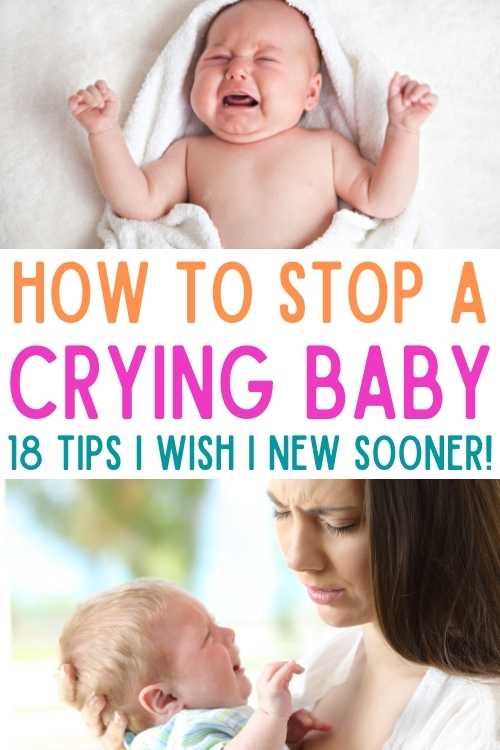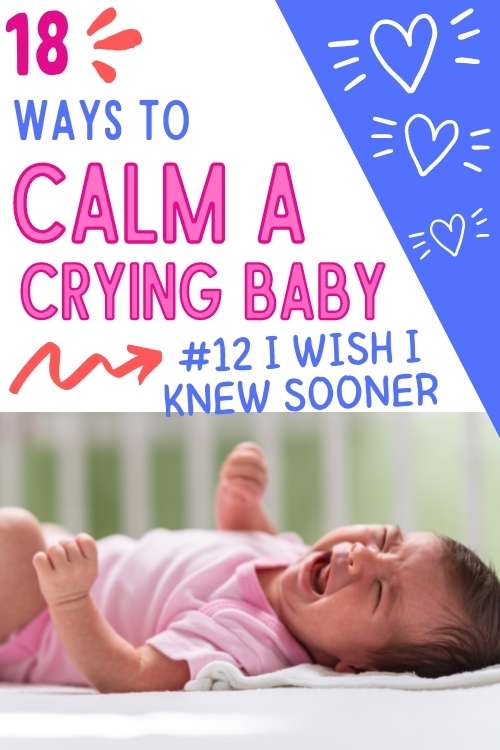Sometimes babies cry, and it can be a heart-wrenching experience. Maybe you’re in public, and your baby is screaming at the top of their lungs while people stare. Or perhaps you’re in your home with no one to turn to for help and you think you might be dealing with a colicky baby.
What do you do? You might feel helpless, but there are ways to soothe a crying baby that work wonders! And I have gathered them all here: 18 of the best tips on how to make a fussy baby stop crying.

Is my Baby just Fussy, or are they in Pain?
First of all, understand that crying is a normal part of being a baby. They’ll likely cry two or three hours each day for the first few weeks, with needs that include hunger, sleepiness, or having bowel motions. And once they get a bit older, they’ll start with teething or sleep regressions, constantly waking up and crying at night: a whole lot of fun for new parents.
Sometimes it can be hard to know what your baby is needing when you hear crying — that takes time and practice. But, as your baby becomes more familiar with the outside world, you’ll likely notice that crying lessens some, and they sleep longer stretches at night. Just know this is normal for healthy babies who are ready to explore their surroundings!
Once you’ve learned what different cries mean, you’ll be able to distinguish between the times your baby is just fussing and when it may be crying out in pain. For example, the noise of more intense wailing or screaming could indicate colic.
If your child is crying excessively, consult with your pediatrician. They may need to be evaluated to find out the cause of excessive crying, especially if there are other symptoms present.
Weak-sounding or soft whining crying could indicate that your baby is not well and may need to be treated by a doctor. You can contact the pediatrician for advice on how to handle it if your baby isn’t getting any better, as well as whether they should examine them in person.
Related:
- 4 Month Sleep Regression (why it is the most important one to get right!)
- Baby Waking Up Multiple Times a Night: here’s what you need to know

Tips on How to Soothe a Crying Baby
Without further ado, here’s all the tips on how to soothe a crying baby.
1) Pick them Up and Hold them Close
Sometimes, a simple rocking motion or walking while holding your baby close can soothe them and make them feel safe. This can become quite hard though, particularly when your baby starts crying the moment you put them down, you are exhausted and you can’t get anything done!
A good tip is to use a baby carrier or baby wrap, at least you don’t have to strain your back or arms every time, and you get to have your hands free. I used to potter around the house with my daughters in the carrier all the time.
I personally loved using a baby wrap (the Baby K’Tan) for when my daughters were very small, then preferred to transition to a baby carrier. With my second daughter though, I also fell in love with hip seat carriers: they behave like normal carriers when the baby is smaller, and then can transition to just a hip seat when baby gets older. Plus they are so much better for your shoulders and backs.
Related: 10 of the Best Hip Seat Carriers
2) Cradle their Head
The feeling of being held close to someone who is protecting us feels very comforting for babies, too. Try cradle their head and give them a gentle massage on their forehead to calm them down.
This is also why I really like the Baby K’Tan for when baby is small: you can easily tuck their head in the wrap and keep them close to you.
3) Distract Them
Babies are often happy when they’re looking at things that catch their interest – maybe it’s an orange toy with big protrusions on top? A mobile phone turned upside down in front of them? An iPad loaded up with cartoons? Find out what your child enjoys seeing and keep it nearby!
There are also a lot of baby chairs and bouncers that have hanging toys for babies to keep them entertained, so you can put them down for a while instead of holding them all the time. Or a play gym is another good option.
Related: 18 Best Baby Chairs for Sitting Up of 2021
4) Sing Softly
Sometimes, hearing Mother Nature’s lullaby will do the trick. Try singing soft songs like “Twinkle, Twinkle Little Star” or “Hush Little Baby” while holding your baby close.
5) Pick up the Pace
Feeling like you’re walking around in circles? Try changing direction and going for a walk with your little one! The change of scenery can provide some distraction, plus it gives them an opportunity to get out their energy.
A trip in the car often does the trick too – I am yet to hear of a little baby that doesn’t stop crying and falls asleep when they are in the car. This works particularly well if you have an overtired baby.
6) Change Positions
If holding or trying to soothe your child isn’t working, try something different, like changing the position of where or how you’re holding your baby. Sometimes just a slight change in how they are being held can help bring them some relief.
In particular, if your baby is upset being held in a cradle hold position (typical breastfeeding position), try holding them upright. If they are upset due to some trapped gas, being upright should help relieve the gas and take the discomfort away.

7) Give Them Kisses
Just leaning over and giving a little peck on the forehead is also often enough to calm an upset baby – try it!
8) Offer a Favorite Toy
Babies can become so overwhelmed by their emotions that they don’t even know what to do with themselves, but sometimes giving them something familiar and comforting (such as one of their favorite toys) will help.
A soft toy or a teddy is definitely something you can try to soothe a crying baby, and is also one of the best tips on how to wean a baby off the pacifier. Show it to your baby and see if they show any interest: if they do, start placing it in bed with them at night, take it out for adventures together, and offer it to your child when they get upset.
Soon they’ll start associating the lovey to a new sense of comfort and will want to take it everywhere with them.
Related: 18 Pacifier Alternatives (for Babies & Toddlers!)
9) Try Swaddling
Swaddling is often very comforting for infants because it provides warmth and security when they feel upset. It also helps keeping kids from excessively moving around while you’re trying to calm them down. Not to mention that they are also perfect to keep baby warm at night, and way safer to use than a baby blanket.
If you can’t be fussed with folding a blanket around your baby, there are lots of swaddles with a zip or with straps that are way easier to use. An example is the Love To Dream Swaddle. Or, if you have a baby girl, also check out this list of best baby girl blankets and swaddles for some ideas.
Related: How to Dress Baby for Sleep
10) Rock the Baby
Rocking a crying child can be very calming for them because it mimics how they felt when they were being held in utero during their mother’s pregnancy. You can also take the help of a baby swing or bouncer, as it can do wonders in soothing a crying baby while freeing up your hands for a while.
There are lots of options when looking for a bouncer or swing: with hanging toys, vibration, music, etc. There are even baby swings that plug into the wall, so you don’t have to worry about running out of battery.
Just be careful not to constantly rock your baby to sleep, otherwise it can become a very strong sleep association for them (they won’t be able to fall asleep without it). If that is the case for you, have a look at some gentle sleep training methods that will teach them how to fall asleep independently.
Related: 6 Sleep Training Methods that ACTUALLY work (and that don’t involve Cry It Out!)
11) Keep the Surrounding Noise Level Down
If you’re at home, try playing some soft music in the background while gently patting your baby’s back and rocking them from side to side. Keep the noise level down, and remove yourself from very loud and crowdy places.
12) Turn On White Noise
White noise can help babies sleep too because it mimics the sound they heard in utero: it creates a comfortable environment that calms baby down and helps them fall asleep.
My favorite white noise machine is the Hushh Portable White Noise Machine: it is portable and I can take it with me in the car or in the stroller.
13) Try a Pacifier
Pacifiers and other kinds of soothing objects can also be helpful when trying to calm baby down. I used one for my first daughter and I couldn’t have done it without it.
We actually used to have about 4 pacifiers in the crib with her, so that she could find at least one in case she lost the one she had in her mouth. Some of them where quite funny pacifiers, so we could also have a laugh when looking at her!
Lots of moms are a bit afraid to introduce a pacifier, in case their baby becomes too dependent on it. But remember that there are lots of easy ways to wean your baby off the pacifier once they grow older!
14) Offer Them Breast Milk or Formula
Offer infants breast milk or formula. For older babies you can also try water or juice in small amounts. There are lots of bottle feeding tips that you can try to make it easier, particularly at night or when out and about.
15) Try Shushing your Baby
Shushing is another good way to soothe a crying infant because it mimics the sound of being in someone’s arms. It is actually one of the best ways to help your baby fall asleep independently, and often encouraged during gentle sleep training methods.
16) Give your Baby a Gentle Massage
Rubbing their back and stroking their hair can be a calming experience for them too, and definitely something else that you can try to help them stop crying. If you like to bath your baby in particular, try incorporate the massage after the bath with some baby lotion (an absolute baby toiletries essential!).
Related: The Ultimate Baby Toiletries List (all Essentials you Need!)

17) Burp them after Feeding
Babies will often fuss and cry if they feel pain or discomfort from gas. Giving a burping session while holding them upright can help soothe your baby, as well as relieve themselves of the excess air in their stomachs.
If you are bottle feeding your baby and you notice that they are often in discomfort after a feeding session, have a look into Paced Bottle Feeding. This bottle feeding technique mimics breastfeeding and really helps reducing the amount of air your baby swallows together with the milk.
18) Make Sure there are No Potential Medical Issues
If none of the tips above helps and your baby won’t stop crying, and this seems like something that should concern you, consult with your pediatrician or other physician first before taking any further steps toward soothing your infant.
The difference between Colic and “Normal Crying”
It’s also quite important to understand the difference between colic and normal crying. In fact, one in five babies suffers from colic and it can be extremely stressful for any new parent.
According to the “rule of threes”, if your baby cries more than three hours a day (for more than three days consecutively) for over three weeks, they may have colic. A colic baby swing might lessen the initial discomfort but you should visit her pediatrician to get tested or seek other advice.
Another sign of colic is a crying fit that sounds more like screaming and lasts for hours on end.
The type of crying that starts off low-pitched and rhythmic can often be resolved with simple soothing, whereas whiny, continuous cries may be a sign that your baby needs to be fed or changed.
Tips on How to Soothe a Crying Baby: Final Thoughts
Here it is mama, all my best tips on how to sooth a crying baby. If all else fails after trying these suggestions, just remember not to lose hope – babies eventually grow out of their fussiness! It may take as little as five minutes, but sometimes it can take up to an hour or more.
Sometimes parents make the mistake of getting frustrated with their child or beating themselves up for not being able to do anything about it. Remember that no one is perfect; given a baby’s needs, anyone would be experiencing constant crying. Look for temporary relief by passing your child to someone else in your life like your partner, mother, friend or sitter and take some time for yourself.
And never shake your baby. Like the frustration shake, vigorous head shaking can cause abusive head trauma (AHT), known as a shaken baby syndrome (SBS). Young infants and toddlers are most susceptible to this kind of injury that causes severe brain damage or death.
If you ever feel like you are too sleep deprived and experiencing a breaking point, put the baby in their crib and go to another room until feeling calm. Strategies that may help, according to the American Academy of Pediatrics (AAP), include taking a breath and counting to 10, calling a friend for emotional support or listening to calming music.
If you’re feeling overwhelmed and would like a professional opinion on your feelings, please contact a crisis hotline, mental health organization or healthcare provider immediately.
For more information, tips and hacks that can help during the first few months with a baby, also check out these posts:
- Signs of Postpartum Anxiety and Tips on How to Deal with it
- How to Survive the First 3 Months with a Newborn
- 8 Tips for New Parents to Avoid Sleep Deprivation
If you are breastfeeding:
- Colic Symptoms & Remedies for Breastfed Babies
- 14 Drinks that Increase Milk Supply
- Sudden Drop in Milk Supply (Signs, Causes & How to Fix it!)
- 20+ Best Online Breastfeeding Courses of 2021 (FREE Classes too!)
- Sore Nipples While Breastfeeding?! 15 Tips that Saved Me!
If you are bottle feeding:
- Paced Bottle Feeding (Benefits & Tips to do it Right!)
- 25 Formula & Bottle Feeding Tips (to Make it Easier!)
About The Author
Amy A. Vincent is a working mom from home blessed with three beautiful kids. She runs a blog named Amy Baby Review, where she provides valuable parenting resources and review kid’s necessary products.
Did you find this useful? Pin It!



Informative post! Those are helpful tips for new moms.